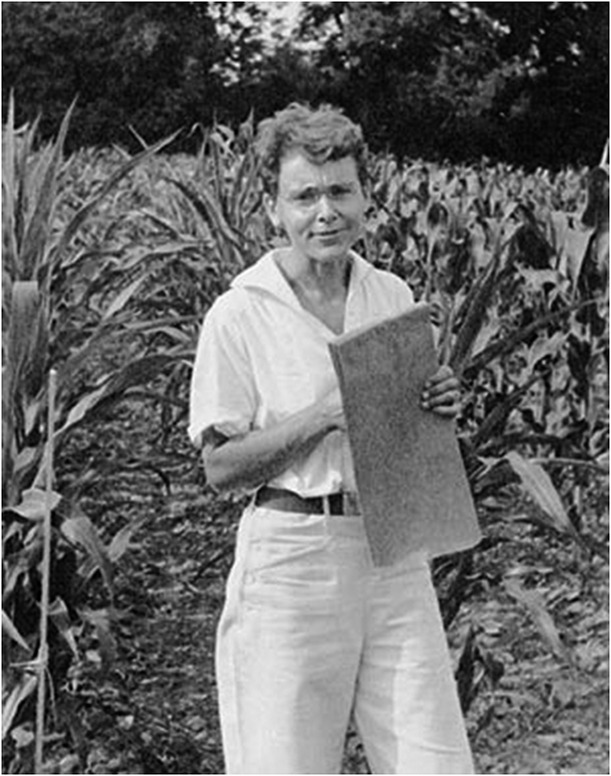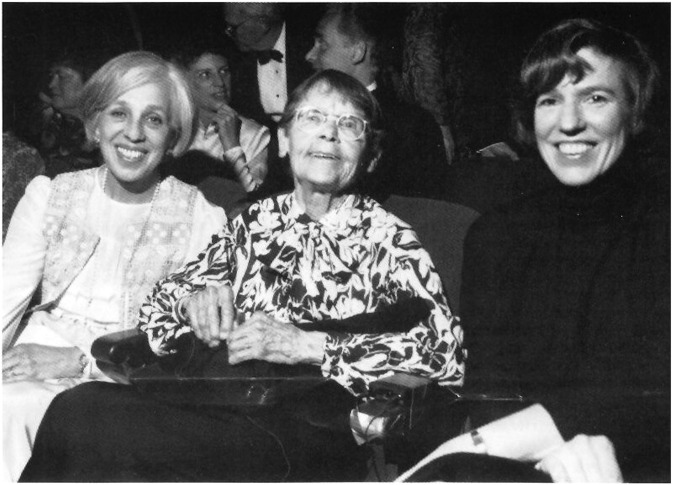
From examination of instability of genic action at a number of known loci in maize, it is concluded that mutations need not express changes in genes, but may be the result of changes affecting the control of genic action. B. McClintock 1953.
It is with this prescient statement that Barbara McClintock began the discussion of her classic 1953 GENETICS article describing how so-called “extragenic” components, now known as transposons, could alter the function of nearby genes. Precisely 30 years later she would be the sole winner of the Nobel Prize in Physiology or Medicine for her scrupulous studies of unexpected phenotypic changes she observed in maize, and the insight that led to her discovery of mobile genetic elements.
While studying the behavior of broken chromosome ends during mitosis, McClintock came across a site on maize chromosome 9 that was sensitive to breakage. Breakage depended on an element that she named Dissociation, or Ds. She identified a second, independent region that was necessary to induce breakage at Ds, the so-called Activator or Ac element. The 1953 article was a follow up to earlier work defining the behavior of the Ac-Ds system (McClintock 1950, 1951), and provided evidence that its effect on the expressivity of traits was generalizable to many loci.
The study focused on pigmentation of the aleurone, the outermost layer of the endosperm, which surrounds and nourishes the maize embryo. McClintock specifically screened for transposition of Ds to two genes, A1 and A2, which are required for the synthesis of the reddish-purple pigment anthocyanin. McClintock constructed tester stocks homozygous for endosperm markers affecting color, morphology, and amylose starch production and located in a chromosome region susceptible to breakage. Using these, she was able to deduce that new Ds mutations behaved in much the same way as Ds insertions at other loci. Because she found similar changes at multiple loci, McClintock concluded that mechanisms controlling gene activity could be independent of the genes themselves. This conclusion predated the characterization of regulatory genes in eukaryotes by several decades, a remarkable achievement. It was made possible through the elegance of McClintock’s genetic schemes, the meticulous documentation of results, and an unflinching confidence in her interpretation of their significance.
Ironically, McClintock’s conclusions about chromosomal instability were published the same year as reports describing the structure of DNA (Franklin and Gosling 1953; Watson and Crick 1953; Wilkins et al. 1953). It would take 30 more years and significant technological advances before the molecular structures of Ac and Ds were finally determined in bold experiments performed by Nina Fedoroff (Fedoroff et al. 1983). DNA sequence analyses verified that Ac encodes a transposase, the enzyme that mediates transposition, whereas the Ds transposon is a defective version of Ac that comes in many forms (Fedoroff 1989).
McClintock’s findings precipitated the search for mobile elements throughout nature. Over half of the human genome consists of transposons. Some are the basis for genomic instability and disease (Hancks and Kazazian 2016), and others, through their influence on gene regulation, are potential mediators of evolutionary change (van’t Hof et al. 2016), or lie dormant as targets for future remobilization. Even now, with genomes fully sequenced and many more tools available to study them, our understanding of their dynamic nature and the impact of transposons on gene function is far from complete.
Barbara McClintock (center) pictured in 1989 with Maxine Singer (left) and Nina Fedoroff (right). McClintock hypothesized the existence of transposons, Fedoroff was the first to characterize them molecularly, and Singer identified transposons in the human genome. Photo courtesy of the Carnegie Institution for Science.
Footnotes
Communicating editor: C. Gelling
ORIGINAL CITATION
Barbara McClintock
GENETICS November 1, 1953 38: 579–599
Image of Barbara McClintock courtesy of Cold Spring Harbor Laboratory Archives.
Literature Cited
- Fedoroff N. V., 1989. About maize transposable elements and development. Cell 56: 181–191. [DOI] [PubMed] [Google Scholar]
- Fedoroff N., Wessler S., Shure M., 1983. Isolation of the transposable maize controlling elements Ac and Ds. Cell 35: 235–242. [DOI] [PubMed] [Google Scholar]
- Franklin R. E., Gosling R. G., 1953. Molecular configuration in sodium thymonucleate. Nature 171: 740–741. [DOI] [PubMed] [Google Scholar]
- Hancks D. C., Kazazian H. H. J., 2016. Roles for retrotransposon insertions in human disease. Mob. DNA 7: 9. [DOI] [PMC free article] [PubMed] [Google Scholar]
- McClintock B., 1950. The origin and behavior of mutable loci in maize. Proc. Natl. Acad. Sci. USA 36: 344–355. [DOI] [PMC free article] [PubMed] [Google Scholar]
- McClintock B., 1951. Chromosome organization and genic expression. Cold Spring Harb. Symp. Quant. Biol. 16: 13–47. [DOI] [PubMed] [Google Scholar]
- McClintock B., 1953. Induction of Instability at Selected Loci in Maize. Genetics 38: 579–599. [DOI] [PMC free article] [PubMed] [Google Scholar]
- van’t Hof A. E., Campagne P., Rigden D. J., Yung C. J., Lingley J., et al. , 2016. The industrial melanism mutation in British peppered moths is a transposable element. Nature 534: 102–105. [DOI] [PubMed] [Google Scholar]
- Watson J. D., Crick F. H., 1953. Genetical implications of the structure of deoxyribonucleic acid. Nature 171: 964–967. [DOI] [PubMed] [Google Scholar]
- Wilkins, M. H. F., A. R. Stokes, and H. R. Wilson, 1953. Molecular Structure of Nucleic Acids: Molecular structure of deoxypentose nucleic acids. Nature 171: 738–740. [DOI] [PubMed] [Google Scholar]
Further Reading in GENETICS
- Bai L., Brutnell T. P., 2011. The Activator/Dissociation Transposable Elements Comprise a Two-Component Gene Regulatory Switch That Controls Endogenous Gene Expression in Maize. Genetics 187: 749–759. [DOI] [PMC free article] [PubMed] [Google Scholar]
- Biémont C, 2010. A Brief History of the Status of Transposable Elements: From Junk DNA to Major Players in Evolution. Genetics 186: 1085–1093. [DOI] [PMC free article] [PubMed] [Google Scholar]
- Fedoroff N. V., 1994. Barbara McClintock (June 16, 1902-September 2, 1992). Genetics 136: 1–10. [DOI] [PMC free article] [PubMed] [Google Scholar]
- Fedoroff N., 1998. Marcus Rhoades and Transposition. Genetics 150: 957–961. [DOI] [PMC free article] [PubMed] [Google Scholar]
- Kass L. B., 2003. Records and Recollections: A New Look at Barbara McClintock, Nobel-Prize-Winning Geneticist. Genetics 164: 1251–1260. [DOI] [PMC free article] [PubMed] [Google Scholar]
- Yu C., Zhang J., Peterson T., 2011. Genome Rearrangements in Maize Induced by Alternative Transposition of Reversed Ac/Ds Termini. Genetics 188: 59–67. [DOI] [PMC free article] [PubMed] [Google Scholar]
Other GENETICS Articles by B. McClintock
- McClintock B., 1929. A Cytological and Genetical Study of Triploid Maize. Genetics 14: 180–222. [DOI] [PMC free article] [PubMed] [Google Scholar]
- McClintock B., 1938. The Production of Homozygous Deficient Tissues with Mutant Characteristics by Means of the Aberrant Mitotic Behavior of Ring-Shaped Chromosomes. Genetics 23: 315–376. [DOI] [PMC free article] [PubMed] [Google Scholar]
- McClintock B., 1941a The Stability of Broken Ends of Chromosomes in Zea mays. Genetics 26: 234–282. [DOI] [PMC free article] [PubMed] [Google Scholar]
- McClintock B., 1941b The Association of Mutants with Homozygous Deficiencies in Zea mays. Genetics 26: 542–571. [DOI] [PMC free article] [PubMed] [Google Scholar]
- McClintock B., 1944. The Relation of Homozygous Deficiencies to Mutations and Allelic Series in Maize. Genetics 29: 478–502. [DOI] [PMC free article] [PubMed] [Google Scholar]
- McClintock B., Hill H. E., 1931. The Cytological Identification of the Chromosome Associated with the R-G Linkage Group in Zea mays. Genetics 16: 175–190. [DOI] [PMC free article] [PubMed] [Google Scholar]



